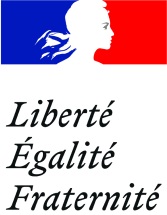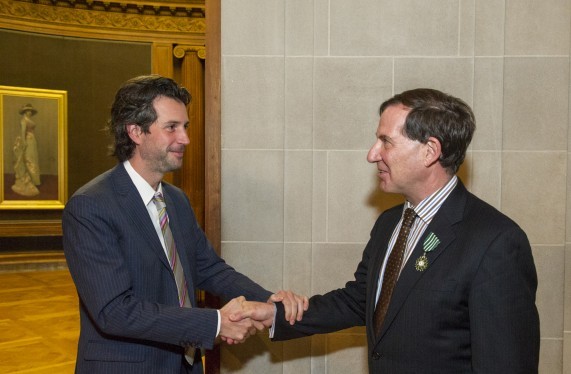Cultural Counselor Antonin Baudry conferred the insignia of the Order of Arts and Letters on Ian Wardropper on June 10, 2013, at a reception co-hosted by the Board of Trustees of The Frick Collection where the event was held. Director of the Frick Collection since 2011, Dr. Wardropper, previously held long-term key positions at the Art Institute of Chicago and the Metropolitan Museum of Art. As a specialist in European sculpture, earlier decorative arts, and twentieth-century design and decorative arts, Dr. Wardropper has advanced the history of art and unfailingly reinforced the cultural bond between France and the United States. In his remarks upon receiving this award, Dr. Wardropper shared a poignant story of his first visit to France on his own as a student and a more recent impression of France while hot air ballooning in Normandy.
Antonin Baudry was introduced by Margot Bogert, Chair of the Board of Trustees.
________________________________________
Introductory Remarks
by Margot Bogert,
Chair of the Board of Trustees of The Frick Collection
It is my pleasure to introduce Antonin Baudry, Cultural Counselor of the French Embassy and Permanent Representative of French Universities in the United States. He directs the cultural division of the French Embassy, whose New York office is located at 79th Street and Fifth Avenue. So he is not only a neighbor to the Frick, but also the activities he supports are dear to the heart of an institution that contains the Fragonard Room and many other French masterpieces.
The insignia he will confer is the Order of Arts and Letters (Ordre des Arts et des Lettres), an award of the French Minister of Culture.
____________________________________________
Conferral Speech
by Antonin Baudry,
Cultural Counselor of the French Embassy in the U.S.
Thank you to Margot Bogert for this introduction, and thank you to the trustees of the Frick Collection for welcoming us this evening.
Dear Ian Wardropper,
Dear Sarah McNear, dear Willa,
Dear friends,
Tonight, we come together at this very special museum to honour a man who belongs to a great “lignée”. The historical line of American professionals of European arts.
Dear Ian,
How do we begin to portray you and your work?
You once said that, if you had to choose an artist to make a bust of you, it would be Alessandro Algardi. He was Bernini’s great rival in the seventeenth century. You choose him because he had a baroque flair and classicizing restraint. Well, I’m sorry, I do not think I have a baroque flair and a classicizing restraint, even if I’m French, but I will try my best. The beauty of these walls will surely inspire me…
When Paul Claudel, the French Ambassador to the United States in the 1930’s, called for the creation of a cultural service in this country, he thought that Americans were best suited to promote French culture. He believed this because of people like you, Ian.
It is not the first time that your path has crossed with the French Embassy. As the Chairman of the Department of European Sculpture and European Arts at the Metropolitan Museum, you created a strong bridge between our two institutions. You sought out what is common between us: our passion for the arts. More specifically, you played a critical role in arranging a long-term loan of our Michelangelo Cupidon. We certainly miss him, but he is in very good hands with our neighbor just across Fifth Avenue.
Your achievements in the European departments of the most prestigious American museums have contributed to the promotion of French arts. While you have numerous achievements, I would like to highlight two. In 2006 and 2007, you brought new life to the Wrightsman Galleries of French Decorative Art, thanks to Philippe de Montebello’s enthusiasm for French art and the hard work of your team. The lighting designer, Larry French – and with such a surname, he could only have done a great job ! – replaced all the lightings to create the feeling of different times of day in the various rooms. Daily, hundreds of visitors are impressed by the coherence and harmony of the furnishings, lighting and their surroundings.
In 2009, you organized an exceptional exhibition entitled Cast in Bronze: French Sculpture from the Renaissance to Revolution at the Met, in collaboration with the Louvre and the Getty in Los Angeles. James David Draper was co-curator and you were an unstoppable team! The exhibition was described as a milestone and I just regret I had not yet moved to New York! The show illustrated not only the artwork but the world in which it was created, by insisting on the historical context and the Italian influences. It revealed the French genius in bronze. Claudel was right, Americans know how to promote our culture!
Dear Ian, your work truly embodies the transatlantic bond between the most prestigious French and American museums.
But above all your influence is international: under your guidance, nine international colloquia took place at the Met in your areas of specialization. And since 2010, you have been a member of the advisory committee of the Réunion des Musées Nationaux for Exhibitions at the Palais du Luxembourg. So, you not only spread your knowledge about French art in your country, but have reached all around the world!
However, I dare say if your renown is international, if your passion is extended to almost every European country, your love story with France is the most enduring! As a graduate student at the Institute of Fine Arts at New York University, you specialized in the French Renaissance. In 1977 you travelled to Paris, where you discovered the wonders of the City of Lights and the rigours of French student life. I hope you enjoyed delving into books on the French Renaissance, while wearing your gloves, in the dead of winter in Labrouste’s beautiful –but freezing!- reading room… This is one of my favourite spots in Paris as well. I think there is a working heater now…
Let’s get back to your Algardi’s bust – that I am still trying to sculpt: according to you, it has to be “specific in detail but discreet in its overall balance”. With such “bon goût”, it is not surprising that you are now the Director of the Frick Collection! Because precisely, what makes the Frick unique is its amazing collection which is displayed in an intimate and dramatic place. A place where decorative arts play an important part. And, this is perfect, since you are also a specialist in early and twentieth century decorative arts! Your passion for the decorative arts shone through with the 2012 exhibition Gold, Jasper, and Carnelian: Johann Cristian Neuber at the Saxon Court, the first show on the work of the remarkable eighteenth-century court goldsmith. The Frick’s current exhibition The Impressionist Line from Degas to Toulouse-Lautrec also highlights France as it features drawings and prints from French masters spanning the entire second half of the nineteenth century.
To paraphrase your words about Algardi’s sculpture, I could add that it’s almost the perfect definition of your expertise: “specific in details, and, more than discreet, I would say ‘remarkable’ in its overall balance”. Thanks to you, dear Ian, the Frick Collection is perhaps one of the smallest museum in America but one of the most important in the richness of its collection.
For your numerous contributions to the history of art, your dedication to reinforce the transatlantic bond between the art institutions of our two countries, but most of all because you are a dear friend of France, it is an honor for me to bestow on you the medal of Knight of the Order of Arts and Letters.
Ian Wardropper, au nom du gouvernement français, je vous fais chevalier dans l’Ordre des Arts et des Lettres.
__________________________________________________
Ian Wardropper’s Remarks
First and last impressions are often the strongest. My first experience of France solo was as a teenager, like many of my generation, hitchhiking around Europe. In the summer of 1970 I found myself in a Latin Quarter café late at night talking with gauchistes–Maoists to be precise–about a worker/student alliance. As illusory as that goal proved to be, I found myself a few days later volunteering on a farm in the Pyrenees, near the village of Urdos, right on the border with Spain. The sons were up in the mountains with the sheep and the farmer needed someone to help cut the tall grass and store it. I learned how to sharpen a scythe, dry the grass, and carry it in. The woman of the house was the strongest, looking like a Millet painting, carrying so much that she was a moving haystack when she walked. They made cheeses and when the door to the cellar opened so they could turn them and rub on salt, the smell staggered me, though the cheese tasted good. The family spoke a patois, which was hard to follow, and as there was no one my age, I would walk down to have a Ricard with a nearby farmer in the evenings. When it was time for me to leave, they offered me money, which I refused; so they loaded me up with an old jacket and as much cheese as I could carry. I hiked off never to return but with a profound sense of the place of land and agriculture in France.
Several weekends ago my wife Sarah and I found ourselves in another part of France, in Normandy at the château de Balleroy for a weekend of hot-air ballooning. This was the second residence built in 1632 by François Mansart, a tall brick and stone structure with possibly the first Mansart roof. It is now owned by the Forbes family. Of course ballooning was a French invention by the Montgolfier brothers in 1783, but Malcolm Forbes became an enthusiast and has left behind a museum and center in the château that his son Kip continues. It turned out to be a perfect day and our pilot glided just feet from the main street before the château, jokingly ordering croissants from the boulangère, before taking us over fields sharply defined by the morning light and cows scattering before us. Coming down to earth was a jolt, but this was softened by the tradition of drinking champagne after a balloon flight. It was a perfectly French weekend of art, music, food and wine, conversation, and whimsical activity.
From first to last, I have had remarkable experiences in France. It is a great honor for me to receive this award from a country whose traditions and art I and so many revere.



